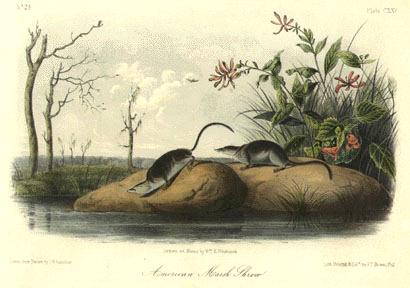

125 American Marsh Shrew
SOREX PALUSTRIS.--RICH.
AMERICAN MARSH SHREW.
[Water Shrew]
PLATE CXXV.--MALES.
S. Mure musculo longior, cauda corporis fere longitudine, auriculis
brevibus, pilosis, vellere absconditis, dorso canescente-nigro, ventro cinereo.
CHARACTERS.
Rather larger than the house mouse; tail, nearly as long as the body; short
hairy ears, concealed by the fur; back, somewhat hoary black; belly, ash colour.
SYNONYMES.
SOREX PALUSTRIS. Rich., Zool. Jour., No. 12, April, 1828.
SOREX PALUSTRIS. Rich., AMERICAN MARSH SHREW. F. B. A., p. 5.
DESCRIPTION.
2 4-4 4-4
Dental Formula.--Incisive -; Canine ---; Molar --- = 30.
2 2-2 3-3
The two posterior lateral incisors are smaller than the two anterior ones
on the same side, and the latter are a little longer than the posterior lobes of
the intermediary incisors; all the lateral incisors have small lobes on their
inner sides. Muzzle, tolerably long, and pointed; upper lip, bordered with
rigid hairs; tips of posterior hairs reaching beyond the ears; the extremity of
the muzzle, naked and bi-lobed; eyes, small but visible; ear, short and
concealed by the fur, its margins folded in; a heart-shaped lobe covering the
auditory opening, and a transverse fold above it. The upper margins of the ears
are clothed with thick tufts of fur. Tail rounded, and covered with hair,
terminated by a small pencil of hair at the tip; feet, clothed with rather short
adpressed hairs, the hairs on the sides of the toes being arranged somewhat
indistinctly in a parallel manner. The fur resembles that of the mole in
softness, closeness, and lustre.
COLOUR.
The tips of the teeth have a shining chestnut-brown tint; the body is black
above, with a slight hoary appearance when turned to the light; on the ventral
aspect ash coloured; at the roots the hair is bluish-gray; the outside of the
thighs and upper surface of the tail correspond in colour with the back; under
surface of the tail, insides of thighs, and belly, greyish-white; feet, paler
than the back.
DIMENSIONS.
Inches. Lines.
Length from point of nose to root of tail, . . 3 6
Length of tail, . . . . . . . . . . . 2 7
Length of head, . . . . . . . . . . . 1 2
Length from nose to eye, . . . . . . . . 0 7
Height of ear, . . . . . . . . . . . 0 3
Length of hind foot from heel to end of nails,. 0 9
HABITS.
The habits of all Shrews (except those of the kind described by
SHAKESPEARE) must necessarily be little known. These animals are so minute in
the scale of quadrupeds that they will always be overlooked, unless sought after
with great zeal, and even then it is often difficult to meet with or procure
them. It may be said that it is only by chance that one is seen and taken now
and then, even where they are known to exist. We have not seen more than five
or six alive during several years, although dead ones have been found by us more
frequently, and upon one occasion we found two that appeared to have recently
died, lying close to each other. No wonder, then, that they may escape the
observation of the most persevering student of nature, as their instinctive
caution would, by causing them either to fly to some little hole or tuft of
grass, or to remain still, when danger was near, render their discovery more
than doubtful; or, if seen, it would be only for a moment. Not the least
singular circumstance connected with the family of Shrews is the fact that they
can exist in extremely cold climates, and move about in winter, when the snow
covers the ground. In his article on Sorex palustris Dr. RICHARDSON says it
"most probably lives in the summer on similar food with the Water Shrew, but I
am at a loss to imagine how it procures a subsistence during the six months of
the year in which the countries it inhabits are covered with snow. It frequents
borders of lakes, and HEARNE tells us that it often takes up its abode in beaver
houses."
We might easily make some probable speculations as to the manners and
customs of the present species, but prefer not doing so farther than to say that
it very likely feeds on seeds, insects, and on the carcases of any small birds
or other animals it finds dead in the fields, that in winter it has a store of
provision laid by, only coming to the snow-covered surface on fine days for the
purpose of getting a little fresh air, and that from the number of tracks
sometimes seen at one place we consider it partly gregarious in its habits.
Our drawing was made from a specimen in the British Museum at London.
GEOGRAPHICAL DISTRIBUTION.
The American Marsh Shrew, according to the writers who have seen it, exists
in the northern parts of our continent from Hudson's Bay to the Coppermine
river.
GENERAL REMARKS.
We are not aware that any author has referred to this animal, except Dr.
RICHARDSON; the specimen from which our drawing was made was the original one
from which Dr. RICHARDSON described, and we believe this species has never been
hitherto figured.
|